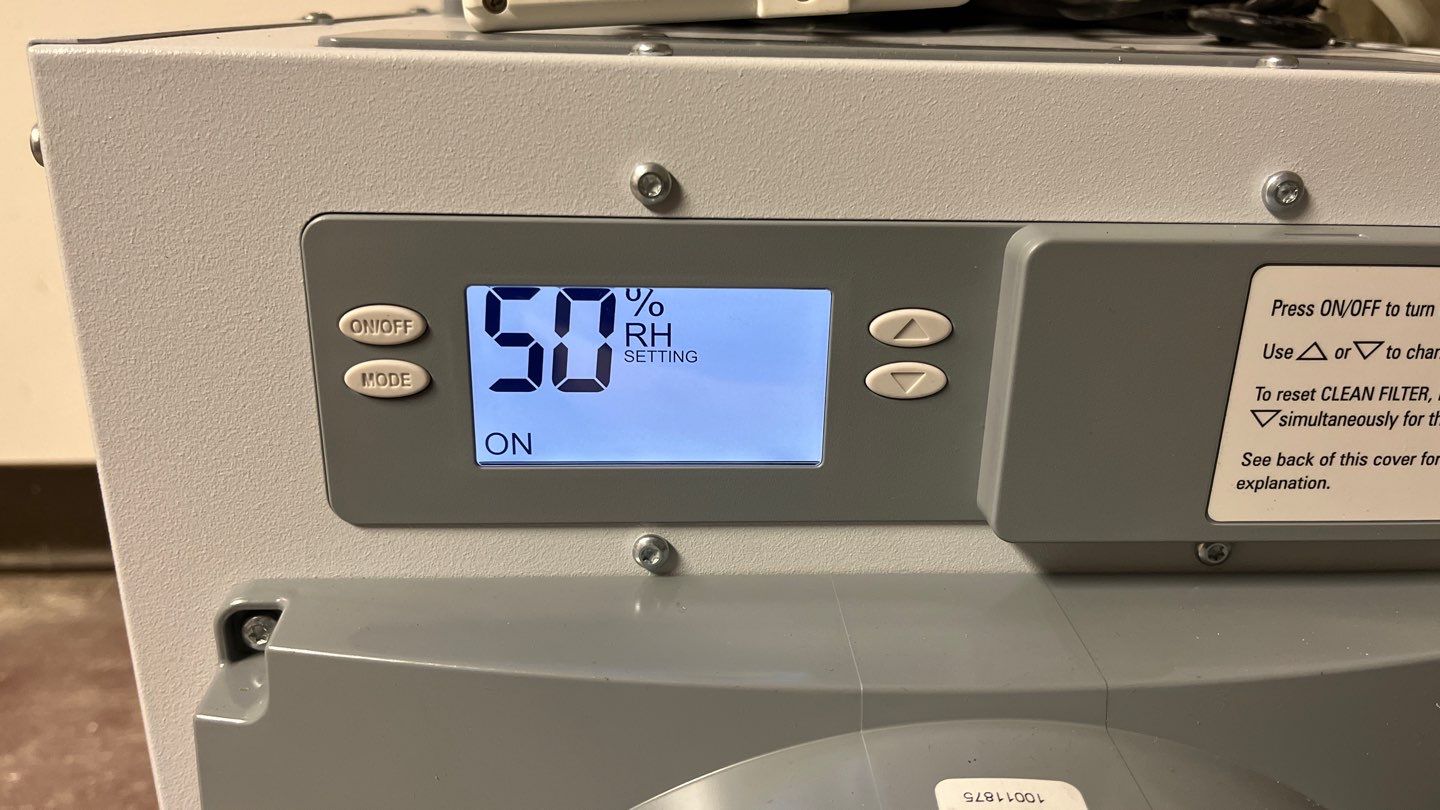When it comes to waterproofing your basement, it’s tempting to just think about keeping water out, but that’s only ever half the battle. If you live in a humid area or you’ve had problems with water ingress before, it’s worth thinking about what to do about the vapor in the air. A basement dehumidifier might be the answer.
What Is A Dehumidifier And How Does It Work?
All air contains a certain amount of water vapor, which is the wet stuff in its gaseous form. We call this humidity. When the humidity levels rise too high, the effects can be pretty similar to what happens in a basement exposed to water in its liquid form.
Dehumidifiers can be a great solution if you’re suffering from the effects of an overly humid home.
How Do Dehumidifiers Work?
The overall aim of a dehumidifier is to remove moisture from the air before it can cause damage. There are two different ways in which they can do this.
Refrigerant Dehumidifiers
When water vapor cools, it forms condensation as it reverts to a liquid state. A refrigerant dehumidifier harnesses this process to remove it from the air and collect it where it can’t do much harm.
A coil is cooled, much like your fridge, and air is drawn across it by a fan. When the air touches the cooled coil, condensation is formed, which then rolls down into the collection chamber to be poured harmlessly away. They’re also called condensing dehumidifiers for obvious reasons.
Desiccant Dehumidifiers
There are two forms of desiccant dehumidifiers, active and passive, but their mechanics are basically the same. The only real difference is that an active model will use a fan to draw air through it (which makes it more effective, but requires power).
Some chemicals, usually silica gel, absorb moisture whenever they come in contact with it (it’s also what you get in those little “do not eat” packets in various products). Working like a sponge, they absorb water from the air.
How Effective are they?
A basement dehumidifier can be a great tool for dealing with certain waterproofing issues. They’ll vastly cut condensation and help ‘freshen’ musty air, but they won’t tackle the source problem and if you’ve got liquid flowing in, they’re probably not the first solution to reach for.
If you are suffering from high humidity, they’re absolutely the right tool for the job.
Signs of High Humidity In Basements
Now that we know that a basement dehumidifier can help with humidity and roughly how they do it, what are the signs that you might need to install a dehumidifier in your basement?
- Condensation: water droplets forming on walls and windows is a sure sign of too much humidity.
- Damp Walls: even if you can’t see droplets on your walls, if they’re damp to the touch, water is getting in somewhere.
- Musty odors: that “basement smell” is a warning sign. It’s hard to fully describe in writing but you’ll know it when you smell it.
- Mold and Mildew: Mold loves damp conditions and humidity is a key source. If you notice black spots forming on walls or stored stuff, it’s time to investigate.
The potential consequences of high humidity are more than simply unpleasant- they can be actively dangerous. Left unattended, mold growth can spiral, ruining your possessions and risking your health. In particularly extreme cases, structural damage may even occur.
Benefits of A Dehumidifier In Your Basement
Without a doubt, if you’re experiencing the signs of an overly humid basement, a dehumidifier will be of great assistance.
Not only will condensation be vastly reduced or even eliminated, your whole home may benefit. Benefits from a dehumidifier include:
- Protect Structural Integrity: It’s an unfortunate fact that water and buildings don’t mix. A dehumidifier can help reduce the pressure on your walls and aid in maintaining your property.
- Preservation Of Stored Items: Basements are a great place to keep all that stuff you don’t want cluttering up your living space but can’t bear to throw out. A basement dehumidifier will help protect them from mold and dampness.
- Increased Air Quality: By tackling damp air, mold growth is reduced or prevented meaning that there are less spores and allergens floating around your home, keeping everyone healthier.
- Increased Energy Efficiency: The cost of running a dehumidifier is vastly lower than the cost of heating humid spaces. It’s good for your wallet and green credentials.
What To Look For In A Basement Dehumidifier
With a huge range of dehumidifiers on the market, it can seem like choosing the right one is an impossible task. Our guide should demystify your basement dehumidifier questions:
CFM
CFM stands for ‘Cubic Feet Per Minute’ and offers a guide to how much air a dehumidifier will dehumidify in a given period. Any dehumidifier will have a CFM rating which lets you know how much air will pass through it per minute. In general, you want a higher CFM for a larger room and a smaller one for smaller spaces
Capacity
The capacity of dehumidifiers relates to how much moisture they can store before they need emptying.
To work out which is right for you:
- Work out the volume of your room (height x length x width)
- Determine the humidity- you can guestimate or use a hydrometer
For a moderately damp room (a ‘damp smell’, say) you want 10 pints capacity for the first 500 cubic feet and an additional 4 pints per 500 feet square. This rises with the humidity levels. There are online calculators which make this simple.
Essential Features
Most dehumidifiers will come with a range of extra features. Ones to keep an eye out for include:
- Humidity Control Settings: humid air is bad for your home, but overly dry air is to be avoided too. Being able to set the levels is a great feature.
- Energy Efficiency Ratings: Mechanical dehumidifiers use electricity to work and that means costs. Going for a highly rated model will save you over the course of its lifetime.
- Ease of Maintenance: like any appliance, maintenance is a fact of life. Having a unit with easily accessible parts will prolong its life considerably.
Whichever model you opt for, it’s always worth weighing up durability and reliability before making a purchase. Check out reviews online.
Are Basement Dehumidifiers Better In Certain Seasons
Depending on where you live, humidity levels can vary massively throughout the year. In general, you’ll see higher humidity when the weather is warmer and wetter- late spring through the fall. This means that your dehumidifier will give the best bang for your buck during these seasons.
As a rule, you’ll want to increase usage during the peak humidity months of summer and may want to switch off entirely during the winter when moisture levels in the air naturally drop. If your model has humidity control settings, it’s a good idea to adjust them to match the season.
As a general rule, it’s best not to run your dehumidifier in winter unless you have a very good reason- it’s usually not necessary.
Alternatives And Complementary Solutions
While basement dehumidifiers are a great tool for dealing with a damp basement, they’re not suitable for every eventuality and, even in cases where they are suitable, partnering them with other solutions can provide even better results:
- Vapor Barriers: Semi or non-permeable layers applied to your basement walls can help your space keep moisture from the surrounding soil from finding its way in in the first place.
- Proper Ventilation: Keeping air moving avoids humidity building up in one place. Vents or pumped systems can improve air flow but even opening windows and doors will allow a space to “air out”.
- Drainage Systems: Whether it’s a sump pump or French drain, guttering or a simple drain, allowing collected water an easy path to escape can save your home from moisture and alleviate problems with flooding too.
An ideal basement waterproofing system will make use of multiple solutions to provide comprehensive cover and a basement dehumidifier can be a vital part of that.
Maintenance Tips
Like any appliance, continued maintenance is a vital part of looking after your dehumidifier and ensuring you get the longest possible use of it. You can expect to get 5-10 years out of most models but looking after them can expand this a bit.
- Empty the collection chamber: A dehumidifier collects water in a chamber. Empty this every so often (ideally before it hits capacity) to ensure that it can keep harvesting moisture from the air.
- Inspect for frost: just like the back of your fridge, ice and frost can build up on a condensing dehumidifier, massively reducing effectiveness. Keep it clear to ensure the best results and that ice doesn’t ruin any moving parts.
- Clean the air intakes and exhausts: dust and various debris will build up over time. Keeping the air flowing well means that things keep running longer.
It’s worth scheduling professional maintenance every so often to ensure that things are running as they should. Keeping humidity levels down is worth the cost in the long run.

